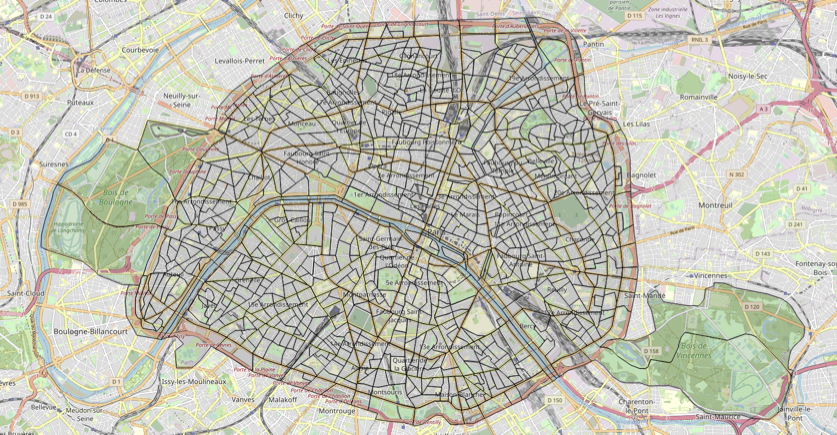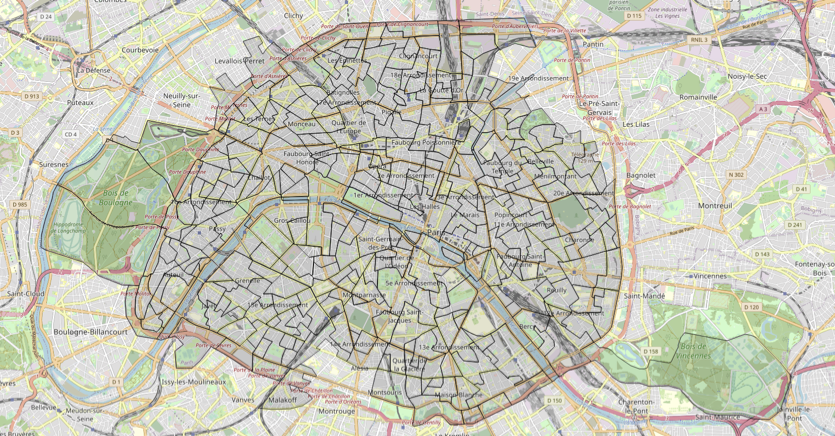SFR Dataset
Data Content
We use a dataset built from call detail records (CDR) and network signaling data (NSD), provided by the French telecom operator SFR. CDR datasets usually contain network signaling events that are time-stamped, geo-referenced (i.e., the cell tower generating the event), and associated with individual mobile devices. The dataset is pre-processed by the operator and represents an aggregation of mobile network data of all the mobile phone subscribers of SFR, covering 20% of the entire population of the studied area.
Privacy compliancy
We note that the European privacy regulations consider as personal data any individual trajectory
data, such as those used in [Ayan et. al., 2021],
even
when the users' identifiers are pseudonymized. In this context, the pre-processed dataset describes
flows counters of geographical zones, aggregated both in time (per hour) and space (i.e., cell tower
communication range). The mobile operator cells were aggregated based on the official units for
statistical information, known as IRIS zones, defined by the French National Institute of Statistics
and Economic Studies (INSEE).
IRIS zones offer the most sophisticated tool to date to describe the internal structure of more than
1,900 municipalities in France with at least 5,000 inhabitants. Some IRIS contain very few active
users who could be identified and are grouped together in the data by the operator to ensure a
proper level of anonymity. The dataset does not contain any information on individual trajectories,
but only information on the number of trips, aggregated per source and destination.
Spatial features
The IRIS zones defined by INSEE must respect geographic and demographic criteria and have borders
that are clearly identifiable and stable in the long term1. IRIS zones offer the most sophisticated
tool to date to describe the internal structure of more than 1,900 municipalities in France with at
least 5,000 inhabitants. Even this level of granularity is too fine in some cases, as some IRIS
contain very few active users who could be identified this way. Therefore, some IRIS are grouped
together by the operator to ensure a proper level of anonymity.
Practically, the dataset covers the city of Paris (i.e., the French department with code 75), for a
total area of 93.76 km2. There are 992 INSEE IRIS zones in the city of Paris, which are
further
aggregated into 326 zones in the SFR dataset. To achieve this level of aggregation, 8% of the INSEE
IRIS were removed by SFR, about 11% of the INSEE IRIS have been kept the same, and the remaining
ones have been merged into groups with size from 2 to 16 INSEE IRIS (an average merging of 2.9 INSEE
IRIS).
Figures below show the original INSEE IRIS fragmentation of Paris and the division provided by SFR
denoted hereafter as
SFR-IRIS, which appears in the studied dataset. In the central metropolitan area, the SFR-IRIS sizes
are smaller, due to their high user attendance, when compared with SFR-IRIS covering parks or more
humanly sparse zones.


Flow information
The provided dataset contains aggregated counter or flow information of several types:
- Continuous user presence – per IRIS zones, we have the number of (static or mobile insider) users observed in the corresponding zone during the entire 1 hour interval.
- Incoming trips – per SFR-IRIS zone, we have the number of users that arrive in the zone during the 1 hour interval. These users have been previously observed in a different area and are now logged in the area of interest.
- Outgoing trips – per SFR-IRIS zone, we have the number of users that leave out the zone during the 1 hour interval. The last known location of these users was in the area of interest, and they are now observed in a different area.
Temporal features
The aggregated dataset covers two weeks before the first lockdown in
France and two weeks during this strict lockdown: i.e., from January 26th to February 8th and from
March 22nd to April 4th. Also, it has a temporal granularity of 1 hour.
For more datails about the dateset temporal features, please access Statistics.